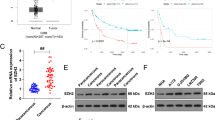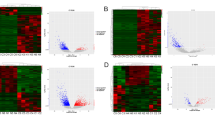Abstract
Background
Osteosarcoma is one of the five leading causes of cancer death among all pediatric malignancies. Recent advances in non-coding RNAs suggested that many long noncoding RNAs (lncRNAs) are dysregulated in cancer tissues and play important roles in carcinogenesis. We aimed to further explore the mechanisms of Long Intergenic Non-Protein Coding RNA 313 (LINC00313)-promoted malignant phenotypes of osteosarcoma.
Methods
The mRNA expressions were determined by quantitative real-time PCR. Protein levels were detected using Western blotting or immunohistochemistry staining. Protein binding to genomic DNA and RNA were measured using chromatin and RNA immunoprecipitation assay, respectively. CCK-8 and EdU incorporation assay were adopted to detect cell proliferation. Transwell assay was employed to assess the capacity of cell migration and invasion. The roles of LINC00313 and its target genes in tumorigenesis and metastasis of osteosarcoma were evaluated using subcutaneous xenograft models and tail vein inoculation models.
Results
LINC00313 was elevated in osteosarcoma tissues compared with adjacent normal tissues. Higher LINC00313 was associated with advanced grades of osteosarcoma. LINC00313 promoted cell proliferation, migration, invasion in vitro and tumor growth as well as metastasis in vivo through inhibiting PTEN expression to promote AKT phosphorylation. Mechanistically, LINC00313 favored the interaction between FUS and EZH2, leading to the prolonged half-life of EZH2 mRNA, thereby in turn up-regulating EZH2 proteins and increasing EZH2-mediated epigenetic silence of PTEN.
Conclusion
LINC00313 exerted oncogene-like actions through increasing EZH2 mRNA stability, leading to PTEN deficiency in osteosarcoma.








Similar content being viewed by others
Availability of data and material
The datasets used or analyzed during the current study are available from the corresponding author on reasonable request.
Code availability
Not applicable.
References
Siegel RL, Miller KD, Fuchs HE, Jemal A (2021) Cancer Statistics, 2021. CA Cancer J Clin 71:7–33
Iyer MK et al (2015) The landscape of long noncoding RNAs in the human transcriptome. Nat Genet 47:199–208
Fang Y, Fullwood MJ (2016) Roles, functions, and mechanisms of long non-coding RNAs in cancer. Genom Proteom Bioinform 14:42–54
Yao RW, Wang Y, Chen LL (2019) Cellular functions of long noncoding RNAs. Nat Cell Biol 21:542–551
Peng WX, Koirala P, Mo YY (2017) LncRNA-mediated regulation of cell signaling in cancer. Oncogene 36:5661–5667
Chi Y, Wang D, Wang J, Yu W, Yang J (2019) Long non-coding RNA in the pathogenesis of cancers. Cells 8(9):1015
Goodall GJ, Wickramasinghe VO (2021) RNA in cancer. Nat Rev Cancer 21:22–36
Ye M, Zhang J, Wei M, Liu B, Dong K (2020) Emerging role of long noncoding RNA-encoded micropeptides in cancer. Cancer Cell Int. https://doi.org/10.1186/s12935-020-01589-x
Ghafouri-Fard S, Shirvani-Farsani Z, Hussen BM, Taheri M (2021) The critical roles of lncRNAs in the development of osteosarcoma. Biomed Pharmacother. https://doi.org/10.1016/j.biopha.2021.111217
Yan L et al (2018) LncRNA CCAT2 promoted osteosarcoma cell proliferation and invasion. J Cell Mol Med 22:2592–2599
Zhang W et al (2020) LncRNA DANCR regulates osteosarcoma migration and invasion by targeting miR-149/MSI2 axis. Eur Rev Med Pharmacol Sci 24:6551–6560
Zhang J, Piao CD, Ding J, Li ZW (2020) LncRNA MALAT1 facilitates lung metastasis of osteosarcomas through miR-202 sponging. Sci Rep. https://doi.org/10.1038/s41598-020-69574-y
Chen H, Wahafu P, Wang L, Chen X (2020) LncRNA LINC00313 Knockdown Inhibits Tumorigenesis and Metastasis in Human Osteosarcoma by Upregulating FOSL2 through Sponging miR-342-3p. Yonsei Med J 61:359
Margueron R, Reinberg D (2011) The Polycomb complex PRC2 and its mark in life. Nature 469:343–349
Kim KH, Roberts CWM (2016) Targeting EZH2 in cancer. Nat Med 22:128–134
Yamagishi M, Uchimaru K (2017) Targeting EZH2 in cancer therapy. Curr Opin Oncol 29:375–381
Khalil AM et al (2009) Many human large intergenic noncoding RNAs associate with chromatin-modifying complexes and affect gene expression. Proc Natl Acad Sci USA 106:11667–11672
Li Y et al (2021) LncRNA PRADX-mediated recruitment of PRC2/DDX5 complex suppresses UBXN1 expression and activates NF-κB activity, promoting tumorigenesis. Theranostics 11:4516–4530
Liu D et al (2017) LncRNA SPRY4-IT1 sponges miR-101-3p to promote proliferation and metastasis of bladder cancer cells through up-regulating EZH2. Cancer Lett 388:281–291
Zhang F, Peng H (2017) LncRNA-ANCR regulates the cell growth of osteosarcoma by interacting with EZH2 and affecting the expression of p21 and p27. J Orthop Surg Res. https://doi.org/10.1186/s13018-017-0599-7
Lv YF, Yan GN, Meng G, Zhang X, Guo QN (2015) Enhancer of zeste homolog 2 silencing inhibits tumor growth and lung metastasis in osteosarcoma. Sci Rep. https://doi.org/10.1038/srep12999
Zhao X, Hu X (2019) Downregulated long noncoding RNA LINC00313 inhibits the epithelial-mesenchymal transition, invasion, and migration of thyroid cancer cells through inhibiting the methylation of ALX4. J Cell Physiol 234:20992–21004
Zheng C et al (2020) PTEN in osteosarcoma: recent advances and the therapeutic potential. Biochem Biophys Acta. https://doi.org/10.1016/j.bbcan.2020.188405
Jamaspishvili T et al (2018) Clinical implications of PTEN loss in prostate cancer. Nat Rev Urol 15:222–234
García JM et al (2004) Promoter methylation of the PTEN gene is a common molecular change in breast cancer. Genes Chromosom Cancer 41:117–124
Wu L, Murat P, Matak-Vinkovic D, Murrell A, Balasubramanian S (2013) Binding interactions between long noncoding RNA HOTAIR and PRC2 proteins. Biochemistry 52:9519–9527
Guo Y et al (2019) LncRNA DLEU2 aggravates the progression of hepatocellular carcinoma through binding to EZH2. Biomed Pharmacother. https://doi.org/10.1016/j.biopha.2019.109272
Thelen MP, Kye MJ (2020) The role of RNA binding proteins for local mRNA translation: implications in neurological disorders. Front Mol Biosci. https://doi.org/10.3389/fmolb.2019.00161
Udagawa T et al (2015) FUS regulates AMPA receptor function and FTLD/ALS-associated behaviour via GluA1 mRNA stabilization. Nat Commun. https://doi.org/10.1038/ncomms8098
Yokoi S et al (2017) 3′UTR length-dependent control of SynGAP isoform α2 mRNA by FUS and ELAV-like proteins promotes dendritic spine maturation and cognitive function. Cell Rep 20:3071–3084
Kim J et al (2018) Polycomb- and Methylation-independent roles of EZH2 as a transcription activator. Cell Rep 25:2808
Sharma V et al (2017) Genome-wide ChIP-seq analysis of EZH2-mediated H3K27me3 target gene profile highlights differences between low- and high-grade astrocytic tumors. Carcinogenesis 38:152–161
Cai Y et al (2021) H3K27me3-rich genomic regions can function as silencers to repress gene expression via chromatin interactions. Nat Commun. https://doi.org/10.1038/s41467-021-20940-y
Duan R, Du W, Guo W (2020) EZH2: a novel target for cancer treatment. J Hematol Oncol. https://doi.org/10.1186/s13045-020-00937-8
Eich ML, Athar M, Ferguson JE, Varambally S (2020) EZH2-targeted therapies in cancer: hype or a reality. Cancer Res 80:5449–5458
Carnero A, Blanco-Aparicio C, Renner O, Link W, Leal J (2008) The PTEN/PI3K/AKT signalling pathway in cancer, therapeutic implications. Curr Cancer Drug Targets 8:187–198
Humtsoe JO, Liu M, Malik AB, Wary KK (2010) Lipid phosphate phosphatase 3 stabilization of beta-catenin induces endothelial cell migration and formation of branching point structures. Mol Cell Biol 30:1593–1606
Song MS, Salmena L, Pandolfi PP (2012) The functions and regulation of the PTEN tumour suppressor. Nat Rev Mol Cell Biol 13:283–296
Luongo F et al (2019) PTEN tumor-suppressor: the dam of stemness in cancer. Cancers (Basel). https://doi.org/10.3390/cancers11081076
Acknowledgements
We thank Hunan UCbio Co., Ltd. for providing technical support for animal experiments.
Funding
This work was supported by Natural Science Foundation of Zhejiang Province (LY19H160047).
Author information
Authors and Affiliations
Corresponding author
Ethics declarations
Conflict of interest
The authors declare no conflicts of interest.
Ethics approval and consent to participate
The specimen collection and processing procedures were approved by the research ethics committee of The First Affiliated Hospital, Zhejiang University. All patients were informed of the study and signed the written consent. All the procedures of animal experiments were approved by the research ethics committee of The First Affiliated Hospital, Zhejiang University.
Consent for publication
The informed consent obtained from study participants.
Additional information
Publisher's Note
Springer Nature remains neutral with regard to jurisdictional claims in published maps and institutional affiliations.
Supplementary Information
Below is the link to the electronic supplementary material.
Supplementary Figure 1. A
Time-series study of LINC00313 post transfection of sh-LINC00313 plasmid in HOS and 143B cells. B Time-series study of LINC00313 post transfection of pcDNA-LINC00313 plasmid in HOS and 143B cells. C Time-series qRT-PCR of PTEN detection post transfection of siPTEN in HOS and 143B cells. D Time-series qRT-PCR of PTEN detection post transfection of pcDNA-PTEN in HOS and 143B cells. E Time-series Western blotting of PTEN detection post transfection of siPTEN in HOS and 143B cells. F Time-series Western blotting of PTEN detection post transfection of pcDNA-PTEN in HOS and 143B cells. G Time-series qRT-PCR of FUS detection post transfection of sh-FUS in HOS and 143B cells. H Time-series qRT-PCR of FUS detection post transfection of pcDNA-FUS in HOS and 143B cells. I Time-series Western blotting of FUS detection post transfection of sh-FUS in HOS and 143B cells. J Time-series Western blotting of FUS detection post transfection of pcDNA-FUS in HOS and 143B cells. K Comparison of LINC00313 knockdown efficiencies between sh-LINC00313 and sh-LINC00313+siPTEN. Comparison of LINC00313 levels between pcDNA-LINC00313 and pcDNA-LINC00313+pcDNA-PTEN in HOS and 143B cells. L Comparison of LINC00313 knockdown efficiencies between sh-LINC00313 and sh-LINC00313+pcDNA-FUS. Comparison of LINC00313 levels between pcDNA-LINC00313 and pcDNA-LINC00313+sh-FUS in HOS and 143B cells. M Comparison of LINC00313 levels between pcDNA-LINC00313 single transfection and co-transfection with other plasmids in HOS cells. N=3. Error bars represented mean ± Standard deviation (SD). *p<0.05, **p<0.01, ***p<0.001 (TIF 1748 KB)
Rights and permissions
About this article
Cite this article
Xing, CY., Zhang, YZ., Hu, W. et al. LINC00313 facilitates osteosarcoma carcinogenesis and metastasis through enhancing EZH2 mRNA stability and EZH2-mediated silence of PTEN expression. Cell. Mol. Life Sci. 79, 382 (2022). https://doi.org/10.1007/s00018-022-04376-1
Received:
Accepted:
Published:
DOI: https://doi.org/10.1007/s00018-022-04376-1




